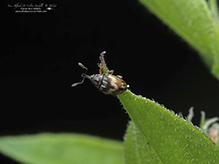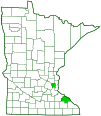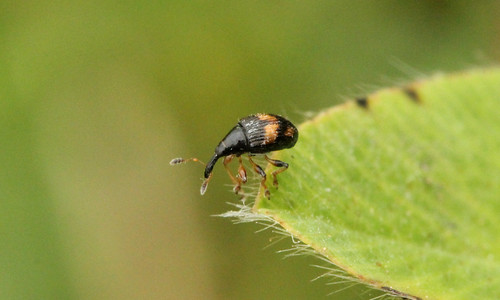flower bud weevil
(Nanophyes marmoratus)
Conservation • Description • Habitat • Ecology • Distribution • Taxonomy
|
|
||||||||||||||
Description |
Flower bud weevil is an exotic, tiny, primitive weevil. It is native to Europe and western Siberia. It was intentionally introduced into North America in the hope that it would help control the spread of invasive purple loosestrife. It was certified for import and release in the U.S. in 1994, and it was first released in 1995. It was distributed to at least seven states. It now occurs in the United States from Maine south to New York and Pennsylvania, and in southern Canada from Nova Scotia to Ontario. Outside of these areas, there are a handful of widely scattered but locally common populations, including in Minnesota. Flower bud weevils feed exclusively on purple loosestrife. The larvae feed on the developing flower buds of the host. Overwintering adults are active in the spring, and the new generation is active from August to September. They feed on leaves and flowers. Flower bud weevils are best detected by finding buds on the ground at the base of the plant, by seeing characteristic exit holes in buds remaining on the plant, and by finding shot-hole damage to leaves. They can also be observed by shaking them from the plant onto a white sheet of paper. Adults are 1⁄16″ to 3⁄32″ (1.5 to 2.5 mm) in length. The body is stout, pear-shaped, and covered with distinct, short, pale hairs. The head is black and is very narrow between the eyes. The beak-like projection of the head (rostrum) is very long, slender, cylinder-shaped, and slightly arced. The surface is longitudinally grooved and strongly pitted (punctate). On the female, the rostrum is longer than the head and the first segment of the thorax (pronotum) combined. On the male it is shorter. The antennae are attached to the sides of the rostrum slightly forward of the middle. They are sharply bent (elbowed), and the last three segments are expanded, forming a loose club. The club is pointed at the end. The pronotum is black and triangular, broadest in the rear and evenly narrowed to the front. The wing covers (elytra) are broadly oval and convex. The color is variable. They are commonly black at the base and yellowish or cream-colored beyond, with an irregular, dark brown to black band in the middle and some black in the rear. The dark markings vary in size and intensity. The elytra are deeply grooved from the base to the tip. The spaces between the grooves are convex. The legs are mostly yellowish. On the male, the fourth segment (tibia) on the hind legs is strongly curved inward. On the female it is straight. On each leg, the first segment (coxa) and the third segment (femur) are more or less darkened. The last part of each leg (tarsus), corresponding to the foot, has five segments, and it is also more or less darkened. |
Size |
Total length: 1⁄16″ to 2⁄32″ (1.5 to 2.5 mm) |
Similar Species |
Habitat |
woodland edges, parks, gardens |
Ecology |
Season |
One generation per year: May to September |
Behavior |
|
Life Cycle |
The female lays usually a single egg on the tip of a flower bud. She lays one or two eggs per day. The larvae feed on the stamens, petals, and ovaries of developing flower buds. This causes the buds to remain closed and most of them soon drop to the ground. The larvae then pupate in a chamber within the bud. Adults feed on the tips of young leaves in the spring. When the flowers begin to open, they feed on the flowers. The new generation of adults appears in August. They feed on leaves. Adults overwinter in leaf litter on the ground. |
Larva Food |
Purple loosestrife |
Adult Food |
Purple loosestrife |
Distribution |
||
|
Sources |
|
| 2/8/2024 | ||
Occurrence |
||
Locally common |
||
Taxonomy |
|
Order |
Coleoptera (Beetles) |
Suborder |
Polyphaga (Water, Rove, Scarab, Long-horned, Leaf, and Snout Beetles) |
Infraorder |
Cucujiformia |
Superfamily |
Curculionoidea (snout and bark beetles) |
Family |
Brentidae (straight-snouted weevils) |
(
Subfamily |
Nanophyinae |
Tribe |
Nanophyini |
Genus |
Nanophyes |
Subordinate Taxa |
|
Nanophyes marmoratus marmoratus |
|
Synonyms |
|
Curculio lythri Curculio marmoratus Nanodes marmoratus Nanophyes lythri |
|
Common Names |
|
flower bud weevil loosestrife seed weevil loosestrife weevil |
|
Glossary
Coxa
The first (most proximal) segment of the legs of most arthropods, including all insects, spiders, and crustaceans, and most arachnids. It attaches the leg to the body and connects to the trochanter. Plural: coxae.
Elytra
The hardened or leathery forewings of beetles used to protect the fragile hindwings, which are used for flying. Singular: elytron.
Femur
On insects and arachnids, the third, largest, most robust segment of the leg, coming immediately before the tibia. On humans, the thigh bone.
Pronotum
The exoskeletal plate on the upper side of the first segment of the thorax of an insect.
Punctate
Dotted with pits (punctures), translucent sunken glands, or colored spots of pigment.
Rostrum
The stiff, beak-like projection of the carapace or prolongation of the head of an insect, crustacean, or cetacean.
Tarsus
On insects, the last two to five subdivisions of the leg, attached to the tibia; the foot. On spiders, the last segment of the leg. Plural: tarsi.
Tibia
The fourth segment of an insect leg, after the femur and before the tarsus (foot). The fifth segment of a spider leg or palp. Plural: tibiae.
Visitor Photos |
||
Share your photo of this insect. |
||
This button not working for you? |
||
Alfredo Colon |
||
 |
|
|
MinnesotaSeasons.com Photos |
||
|
||
|
||

Visitor Videos |
||
Share your video of this insect. |
||
This button not working for you? |
||
ContributorName |
|
Other Videos |
||
|

|
Created: 2/8/2024 Last Updated: © MinnesotaSeasons.com. All rights reserved. |




